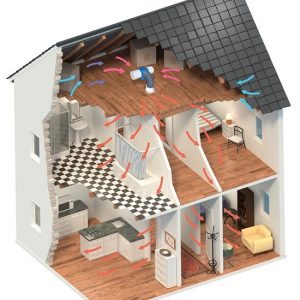Fastlec uses cookies to ensure that we give you the best experience on our website. If you continue we assume that you consent to receive all cookies on the Fastlec website. Read More.
Blog
All of the latest news and insights into the electrical world, from Fastlec.
Should you buy the heated or unheated version of a PIV Unit?
If you are considering purchasing a PIV (Positive Input Ventilation) unit for your home, one of the decisions you will need to make is whether to opt for a model with or without a pre-heater. A pre-heater is an additional component that warms the incoming air before it is circulated through the home by the PIV unit. In this article, we will explore the advantages and disadvantages of purchasing a PIV unit with or without a pre-heater to help you make an informed decision.
Benefits of an Unheated PIV Unit System
First, let's examine the benefits of a PIV unit without a pre-heater. This type of unit is generally less expensive to purchase and install. It is also simpler in design, with fewer components that can potentially malfunction or require maintenance. Without a pre-heater, the unit can still help to reduce condensation, dampness, and mould in your home by bringing in fresh, filtered air from outside and circulating it throughout the living spaces. In addition, a PIV unit without a pre-heater can help to improve indoor air quality by removing stale air and pollutants.
Examples of Unheated PIV Units:
Benefits of a Pre-Heater PIV Unit System
On the other hand, a PIV unit with a pre-heater can offer some distinct advantages. First and foremost, a pre-heater can warm up the incoming air, making your home more comfortable and reducing the need for additional heating in colder months. This can be especially useful in areas with colder climates, as it can help to offset the cost of running the PIV unit. A pre-heater can also help to reduce the risk of condensation forming within the unit, which can extend the lifespan of the unit and prevent the need for repairs or replacement.
Examples of Heated PIV Units:
- DRI-ECO-HEAT-HCS Nuaire PIV Unit with Integral Heater
- 479091 Vent Axia PIV Unit with Integral Heater
Consistency and Comfort
Another benefit of a PIV unit with a pre-heater is that it can provide more consistent ventilation throughout the home. Without a pre-heater, the temperature of the incoming air can vary depending on the outside temperature, which can lead to fluctuations in indoor temperature and humidity levels. By warming the incoming air, a pre-heater can help to maintain a more consistent temperature and reduce the risk of discomfort or health issues associated with exposure to cold air.
Ultimately, the decision of whether to purchase a PIV unit with or without a pre-heater will depend on a number of factors, including your climate, budget, and personal preferences. If you live in a warmer climate or have a limited budget, a PIV unit without a pre-heater may be sufficient to meet your needs. However, if you live in a colder climate or want to enjoy more consistent temperatures throughout the home, a PIV unit with a pre-heater may be worth the investment.
In summary, a PIV unit with a pre-heater offers several benefits, including improved comfort, more consistent ventilation, and a reduced risk of condensation. However, it is also more expensive to purchase and install than a unit without a pre-heater. Consider your individual circumstances, preferences, and budget when making a decision about which type of PIV unit to purchase.
Pre-Heater Costs
To calculate the cost of running a PIV unit with a pre-heater at 35p per kilowatt-hour (kWh), we would need to know the wattage of the pre-heater and the length of time it is in operation.
Assuming an average wattage of 500 watts for the pre-heater and an average daily use of 4 hours, the calculation would be as follows:
500 watts x 4 hours = 2000 watt-hours (Wh) per day 2000 Wh / 1000 = 2 kWh per day 2 kWh x 35p = 70p per day
Therefore, running a PIV unit with a pre-heater at 35p per kWh for 4 hours per day would cost approximately 70p per day. This equates to roughly £25.50 per month or £306 per year.
It is worth noting that actual costs may vary depending on factors such as local electricity rates, the efficiency of the PIV unit, and the frequency and duration of pre-heater use.



